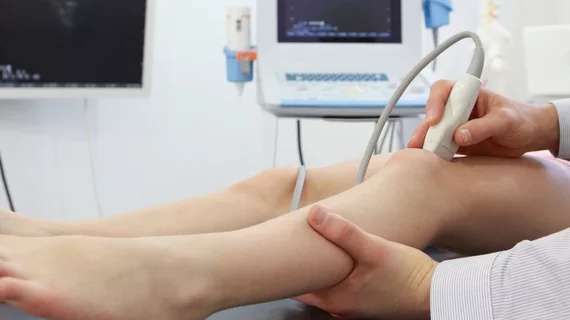Musculoskeletal ultrasound may reduce unnecessary MRI, maintain accuracy
Imaging providers may be ordering more MRI examinations than necessary. Ultrasound may serve as an advanced imaging modality that reduces the need for additional MRI examinations for musculoskeletal (MSK) imaging, according to a study published May 5 in the Journal of the American College of Radiology.
Utilizing MSK ultrasound before MRI is a growing trend, according to lead author Lulu He, DO, a radiologist at Mercy Fitzgerald Hospital in Darby, Pennsylvania, and colleagues. MRI examinations are often ordered and performed after diagnostic ultrasounds for the same or similar clinical concerns—and they can produce redundant results.
"We hypothesized that when used appropriately, ultrasound examinations provide results that are comparable with those obtained with MRI and that MRI performed after ultrasound therefore rarely changes the diagnosis," the researchers wrote.
Data from MRI performed within 90 days after diagnostic MSK ultrasound exams from Jan. 5, 2012, to Nov. 27, 2015, were collected for retrospective analysis. Two radiologists, both with 17 years of experience in MSK imaging, then compared the ultrasound and MRI reports.
Additionally, 129 of 6,376 ultrasound exams followed by MRI studies fit the researchers' inclusion criteria for analysis.
"This reflected a lower incidence of potentially redundant imaging than was expected for our institution," according to the researchers. "Presumably, this is the result of ongoing formal lectures for referring clinicians regarding the appropriate use of ultrasound examinations, dedicated ultrasound examination schedulers who assess for appropriate indications before scheduling and diversion of potentially inappropriate requests for approval by the radiologist."
Ultrasound and MRIs reports were categorized by the two radiologists as either concordant ("no difference or minor difference between ultrasound and MRI results") or discordant ("potentially clinically important difference between ultrasound and MRI results"), according to study methods.
For reports determined as discordant, ultrasound and MRI were reviewed by both radiologists on PACS stations and jointly categorized as either concordant ("ultrasound and MRI could be interpreted similarly") or discordant ("ultrasound and MRI could not be interpreted similarly").
Results demonstrated high concordance between ultrasound and follow-up MRI reports (86 percent) and images (96 percent) for a variety of MSK indications, the researchers wrote. Wording variation, interpretation errors and inappropriate ultrasound examination use were determined as factors contributing to report discordance.
"Ultrasound may be complementary to MRI or even a preferred alternative for a wide range of MSK pathologies," the researchers concluded. "Our findings substantiate and support the conclusion that the use of ultrasound in place of MRI does not compromise diagnostic accuracy and offers the potential for substantial cost savings."

